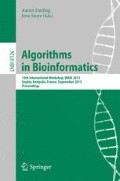Abstract
Evolution is a process that is influenced by various environmental factors, e.g. the interactions between different species, genes, and biogeographical properties. Hence, it is interesting to study the combined evolutionary history of multiple species, their genes, and the environment they live in. A common approach to address this research problem is to describe each individual evolution as a phylogenetic tree and construct a tree reconciliation which is parsimonious with respect to a given event model. Unfortunately, most of the previous approaches are designed only either for host-parasite systems, for gene tree/species tree reconciliation, or biogeography. Hence, a method is desirable, which addresses the general problem of mapping phylogenetic trees and covering all varieties of coevolving systems, including e.g., predator-prey and symbiotic relationships. To overcome this gap, we introduce a generalized cophylogenetic event model considering the combinatorial complete set of local coevolutionary events. We give a dynamic programming based heuristic for solving the maximum parsimony reconciliation problem in time O(n 2), for two phylogenies each with at most n leaves. Furthermore, we present an exact branch-and-bound algorithm which uses the results from the dynamic programming heuristic for discarding partial reconciliations. The approach has been implemented as a Java application which is freely available from http://pacosy.informatik.uni-leipzig.de/coresym .
Access this chapter
Tax calculation will be finalised at checkout
Purchases are for personal use only
Preview
Unable to display preview. Download preview PDF.
References
Berglund-Sonnhammer, A.C., Steffansson, P., Betts, M., Liberles, D.: Optimal gene trees from sequences and species trees using a soft interpretation of parsimony. J. Mol. Evol. 63(2), 240–250 (2006)
Brooks, D.: Parsimony analysis in historical biogeography and coevolution: methodological and theoretical update. Syst. Biol. 39(1), 14–30 (1990)
Charleston, M.: Jungles: a new solution to the host/parasite phylogeny reconciliation problem. Math. Biosci. 149(2), 191–223 (1998)
Charleston, M., Perkins, S.: Traversing the tangle: algorithms and applications for cophylogenetic studies. J. Bio. Med. Inform. 39(1), 62–71 (2006)
Chen, K., Durand, D., Farach-Colton, M.: NOTUNG: a program for dating gene duplications and optimizing gene family trees. J. Comput. Biol. 7(3-4), 429–447 (2000)
Conow, C., Fielder, D., Ovadia, Y., Libeskind-Hadas, R.: Jane: a new tool for the cophylogeny reconstruction problem. Algorithms Mol. Biol. 5, 16 (2010)
Doyon, J.P., Scornavacca, C., Gorbunov, K.Y., Szöllosi, G., Ranwez, V., Berry, V.: An efficient algorithm for gene/species trees parsimonious reconciliation with losses, duplications and transfers (2010)
Goodman, M., Czelusniak, J., Moore, G., Romero-Herrera, A., Matsuda, G.: Fitting the gene lineage into its species lineage, a parsimony strategy illustrated by cladograms constructed from globin sequences. Syst. Biol. 28(2), 132–163 (1979)
Hafner, M.S., Nadler, S.A.: Phylogenetic trees support the coevolution of parasites and their hosts. Nature 332(6161), 258–259 (1988)
Hafner, M., Nadler, S.: Cospeciation in host-parasite assemblages: comparative analysis of rates of evolution and timing of cospeciation events. Syst. Biol. 39(3), 192–204 (1990)
Hendy, M., Little, C., Penny, D.: Comparing trees with pendant vertices labelled. Siam J. Appl. Math. 44(5), 1054–1065 (1984)
Merkle, D., Middendorf, M.: Reconstruction of the cophylogenetic history of related phylogenetic trees with divergence timing information. Theory Biosci. 123(4), 277–299 (2005)
Merkle, D., Middendorf, M., Wieseke, N.: A parameter-adaptive dynamic programming approach for inferring cophylogenies. BMC Bioinformatics 11(S-1), 60 (2010)
Nelson, G., Ladiges, P.Y.: Three area statements: standard assumptions for biogeographic analysis. Syst. Zool. 40, 470–485 (1991)
Nelson, G., Platnick, N.: Systematics and biogeography: cladistics and vicariance. Columbia University Press (1981)
Ovadia, Y., Fielder, D., Conow, C., Libeskind-Hadas, R.: The co-phylogeny reconstruction problem is NP-complete. J. Comput. Biol. 18(1), 59–65 (2011)
Page, R.D.M.: Tangled Trees. Phylogeny, Cospeciation and Coevolution. The University of Chicago Press (2003)
Page, R.: Quantitative cladistic biogeography: constructing and comparing area cladograms. Soc. Syst. Zool. (1988)
Page, R.: Maps between trees and cladistic analysis of historical associations among genes, organisms, and areas. Syst. Biol. 43(1), 58–77 (1994)
Page, R.D.M.: GeneTree: comparing gene and species phylogenies using reconciled trees. Bioinformatics 14(9), 819–820 (1998)
Page, R., Charleston, M.: Trees within trees: phylogeny and historical associations. Trends Ecol. Evol. 13(9), 356–359 (1998)
Patro, R., Sefer, E., Malin, J., Marçais, G., Navlakha, S., Kingsford, C.: Parsimonious reconstruction of network evolution. Algorithms Mol. Biol. 7(1), 25 (2012)
Ronquist, F.: Dispersal-vicariance analysis: a new approach to the quantification of historical biogeography. Syst. Biol. 46(1), 195–203 (1997)
Ronquist, F., Nylin, S.: Process and pattern in the evolution of species associations. Syst. Biol. 39(4), 323–344 (1990)
Ronquist, F., Sanmartín, I.: Phylogenetic methods in biogeography. Annu. Rev. Ecol. Evol. Syst. 42, 441–464 (2011)
Szollosi, G.J., Tannier, E., Lartillot, N., Daubin, V.: Lateral gene transfer from the dead. Syst. Biol. 62(3), 386–397 (2013)
Vernot, B., Stolzer, M., Goldman, A., Durand, D.: Reconciliation with non-binary species trees. J. Comput. Biol. 15(8), 981–1006 (2008)
Zandee, M., Roos, M.C.: Component-compatibility in historical biogeography. Cladistics 3, 305–332 (1987)
Zmasek, C., Eddy, S.: A simple algorithm to infer gene duplication and speciation events on a gene tree. Bioinformatics 17(9), 821–828 (2001)
Author information
Authors and Affiliations
Editor information
Editors and Affiliations
Rights and permissions
Copyright information
© 2013 Springer-Verlag Berlin Heidelberg
About this paper
Cite this paper
Wieseke, N., Bernt, M., Middendorf, M. (2013). Unifying Parsimonious Tree Reconciliation. In: Darling, A., Stoye, J. (eds) Algorithms in Bioinformatics. WABI 2013. Lecture Notes in Computer Science(), vol 8126. Springer, Berlin, Heidelberg. https://doi.org/10.1007/978-3-642-40453-5_16
Download citation
DOI: https://doi.org/10.1007/978-3-642-40453-5_16
Publisher Name: Springer, Berlin, Heidelberg
Print ISBN: 978-3-642-40452-8
Online ISBN: 978-3-642-40453-5
eBook Packages: Computer ScienceComputer Science (R0)

